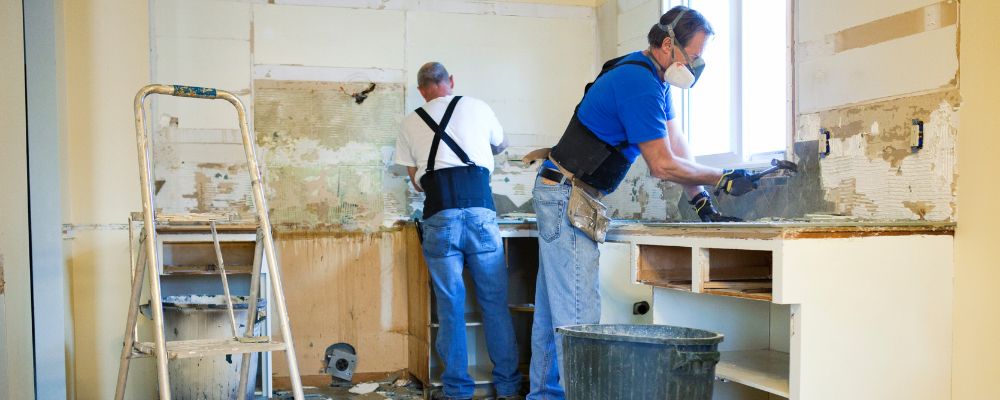If you're a homeowner in Scotland considering a renovation project, you've come to the right place. Grab a cuppa, and let's dig deep into the foundations of your typical home renovation.
Why Renovate?
Before we get into the nitty-gritty, let's talk about why you might want to renovate in the first place. Most of the time, it might be that your family's growing faster than your house can keep up with, and you're tired of queuing for the loo every morning. Whatever your reason, renovations can breathe new life into your home and potentially increase its value. It's a win-win situation!
Types of Renovations
Now, renovations come in all shapes and sizes. You might be thinking of:
- Adding an extra bedroom (for when the in-laws visit, of course)
- Extending your kitchen (to accommodate your growing cookbook collection)
- Converting your attic or basement (perfect for a secret whisky-tasting room)
- Installing a new bathroom (no more fights over sink space!)
- Upgrading your heating system (because Scottish winters are no joke)
- Replacing windows and doors (to keep the drafts out and the warmth in)
- Installing a new roof (to protect you from the "occasional" Scottish rain)
- Revamping your garden (for those three days of summer)
The Practicalities Behind a Home Renovation
It's time for a wee reality check before you start picking out fancy tiles and designer light fixtures. Take a good, hard look at your home— and we mean really look.
Go room by room, inside and out, and make a list of any issues you spot. Are there any cracks in the walls? Does the roof look like it's seen better days? Is the wiring older than the legend of Nessie? These are the things you need to address before you start thinking about that fancy new kitchen island that'll give the town gossips plenty of ammo for the next couple of weeks.
Why? Because these structural issues can throw a spanner in the works of your renovation plans faster than you can say, "Och!". Plus, addressing these problems first guarantees the safety and security of your home. After all, what's the point of a swanky new extension if your roof's about to cave in?
Time To Plan
Now that you've got a clear picture of your home's current state, it's time to start planning. This is where the fun begins!
First, think about the purpose of your renovation. Are you modernising an outdated space? Adding more room for your growing family? Or maybe you're finally building that home cinema you've always dreamed of? Understanding your 'why' will help guide your decisions throughout the process.
Next, it's time to get inspired. Browse home design magazines, scroll through Pinterest, or take a wander through your local home improvement store. Take pictures, save links, and start creating a vision board for your project. Just remember, while that marble waterfall countertop might look fabulous in a magazine, it might not be the most practical choice for a family with three kids and a large dog.
Depending on the scale of your project, consider hiring an architect. They can help you make the most of your available space, make sure your plans are feasible, and might even propose ideas you hadn't thought of. Plus, they'll make sure your plans comply with local building regulations, which is crucial if you're making significant changes to your home's structure.
The DIY Dilemma
Now, here's a question that plagues many Scottish homeowners: Should you do a DIY or hire a professional? It's tempting to save a few quid by doing it yourself, especially if you're handy with a hammer. But before you don your tool belt, consider the following:
- Your skill level: Be honest with yourself. That YouTube tutorial might make tiling look easy, but are you really up for the job?
- Time: DIY often takes longer than professional work. Are you prepared for your home to be a construction site for months on end?
- The complexity of the job: Painting a room? Sure, go for it. Rewiring your entire house? Leave that to the professionals.
- Cost: While DIY is often cheaper upfront, mistakes can be costly. Hiring a professional from the start can save you money in the long run.
If you do decide to hire professionals, do your research. Look for reputable local tradespeople, check their reviews and work history, and don't hesitate to ask for references. Remember, the cheapest quote isn't always the best option.
The Not-So-Fun (but Very Important) Part — Budgeting
The budget. It's not the most exciting part of the renovation but arguably the most important. Your budget will depend on several factors:
- The size of the project
- The cost of materials and fixtures
- Labour costs
- The age of your property (older homes often hide expensive surprises)
Research average costs for similar projects in your area to get a ballpark figure. Then, add an extra 10-20% as a buffer. And take into account the extra packaging materials and their costs.
Remember, a good tradesperson can often help you keep costs down. They might know where to source more affordable materials or have ideas for cost-effective alternatives that still look great.
Preparing for the Renovation
Once you've got your plans and your team lined up, it's time to prepare for the renovation. Here are a few tips to make the process smoother:
- Remove furniture and personal items from the renovation zone. If you need extra space, consider renting a storage unit.
- Cover floors and furniture that can't be moved with dust sheets.
- Renovations are messy and noisy. If you're staying in the house during the work, plan how you'll manage without the room(s) being renovated.
- Establish a good relationship with your contractors. Regular check-ins can help catch potential issues early.
- Be flexible: Despite the best planning, unexpected issues can arise. Be prepared to make decisions on the fly and possibly adjust your plans.
- Take photos before, during, and after the renovation. They're great for showing off your new space on social media and can also be helpful if any disputes arise.
The Aftermath
Once the dust has settled (literally), it's time to enjoy your newly renovated space. But before you kick back and relax, there are a few final steps:
- Make sure everything has been completed to your satisfaction.
- Clean up. Even with the best contractors, there's likely to be some residual dust and debris.
- Update your home insurance as your renovations may have increased the value of your home, so make sure your insurance coverage reflects this.
- Maintain your new space through regular maintenance that will help keep your renovations looking fresh for years.
Renovating your home is a big undertaking, but with proper planning and preparation, it can be an enriching experience. Remember, Rome wasn't built in a day, and your perfect home won't be either. But with patience, perseverance, and perhaps a wee dram to celebrate each milestone, you'll get there. Happy renovating!
And speaking of being prepared, don't forget about the importance of storage during your renovation journey. That's where Len's Self Storage comes in handy. With secure, flexible storage solutions, Len's can help keep your belongings safe and out of the way while your home transforms.
Contact Len's Self Storage today to see how we can make your renovation process that much smoother.






